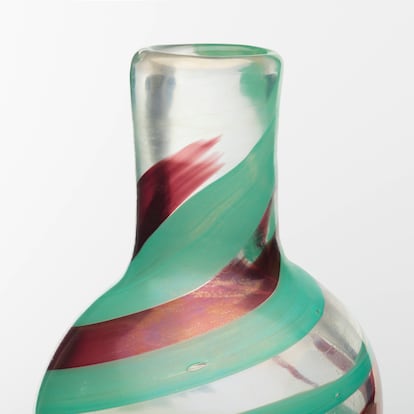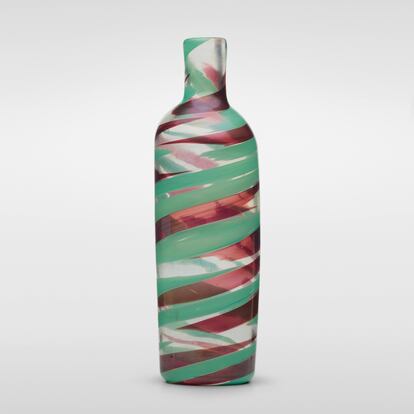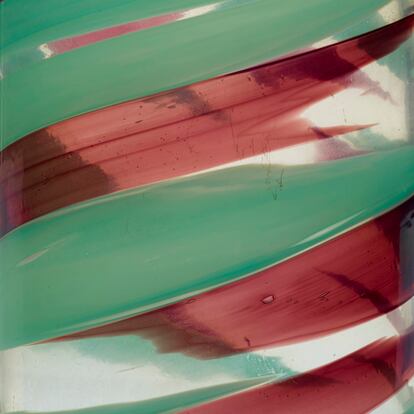A stroke of luck: The vase found in a thrift store for $3.99 that went under the hammer for $107,100
Jessica Vincent found the painted glass Murano piece designed by renowned architect Carlo Scarpa on the shelves of a thrift store

A trainer of polo ponies, Jessica Vincent, 43, was sifting through the junk in a Goodwill store in Hanover County, Virginia, U.S., when a glass vase caught her eye. Painted in swirls of red and green, it stood out among the other objects stacked on the shelf. Taken with the piece, Vincent decided to buy it for her home. The price was just $3.99 and as she went to the cashier to pay, she noticed two details on the base of the vase: an ‘M’ and the word ‘Italia.’ From then on, the vase ceased to be just another decorative object and became the focus of an investigation. Vincent was about to prove she had a good eye.
Vincent’s research confirmed that the vase was a rare piece from Murano, the mythical Venetian island famous for centuries of handcrafted glassware. The vase has just gone under the hammer for $107,000 at the Wright Auction House, sold to a private European collector, who prefers to remain anonymous. “I had a sense that it might be a $1,000 or $2,000 piece, but I had no clue how good it actually was until I did a little bit more research,” she told The New York Times.

The vase is one of two remaining pieces in good condition from the Pennellate series, designed by Carlo Scarpa, the great Italian mid-twentieth century architect who, besides creating iconic buildings and interiors, also designed glass objects. His style, which focuses on shaping beautiful materials into simple but noble forms, is perfectly captured in this series. The name of the series, Pennellate, translates as brushstroke and reveals a unique artisanal process. The goal of the artisans who worked with Scarpa in the 1940s was to simulate brushstrokes through a complex technique that, instead of painting the finished surface, adds opaque colored glass to the vase during the blowing process. The challenges involved in this process meant that there were very few pieces in a collection that is now considered unique.
At the time of purchase, Vincent only suspected she might be onto something. She joined groups specializing in glassware on Facebook, who put her in touch with the Wright Auction House, a specialist in glass and crystal pieces. Richard Wright, president of the company, called Vincent after receiving the images she sent him. “The moment I saw the photos, I had a really good feeling,” he said. The auctioneer explained that it is rare to find a piece in such pristine condition: “If it had a chip — even a small chip — it would have probably sold for under $10,000,” he said. “This was like a winning lottery ticket.”
Vincent says that one of the highlights of the investigation was the evaluation of the vase by various experts. “The expression on their faces was quite striking,” she says. “It was amazing that experts who work with very important pieces of glass were so excited about my little thrift store vase.” Their excitement, as reflected by the final price, was well-founded. In fact, the cover of the digital catalog for the auction, generally dedicated to pieces of glass of Italian origin, was a detail of Scarpa’s brushstrokes, unmistakable to any collector of this type of piece.

Vincent is very pleased with her discovery. The horse trainer is a fan of TV programs like Antiques Roadshow, where professionals browse thrift stores in search of hidden treasure. “I always felt I had a good eye,” said Vincent, who frequently visits such stores with her partner. “But I’m really surprised no one discovered it before me.” Although she has stumbled upon other pieces of value in the past, such as artwork valued at several thousand dollars, she never thought she would get this lucky. “You never know what you’re going to find,” she says. “It’s the thrill of the hunt.”
Sign up for our weekly newsletter to get more English-language news coverage from EL PAÍS USA Edition
Tu suscripción se está usando en otro dispositivo
¿Quieres añadir otro usuario a tu suscripción?
Si continúas leyendo en este dispositivo, no se podrá leer en el otro.
FlechaTu suscripción se está usando en otro dispositivo y solo puedes acceder a EL PAÍS desde un dispositivo a la vez.
Si quieres compartir tu cuenta, cambia tu suscripción a la modalidad Premium, así podrás añadir otro usuario. Cada uno accederá con su propia cuenta de email, lo que os permitirá personalizar vuestra experiencia en EL PAÍS.
¿Tienes una suscripción de empresa? Accede aquí para contratar más cuentas.
En el caso de no saber quién está usando tu cuenta, te recomendamos cambiar tu contraseña aquí.
Si decides continuar compartiendo tu cuenta, este mensaje se mostrará en tu dispositivo y en el de la otra persona que está usando tu cuenta de forma indefinida, afectando a tu experiencia de lectura. Puedes consultar aquí los términos y condiciones de la suscripción digital.
More information
Archived In
Últimas noticias
Most viewed
- Sinaloa Cartel war is taking its toll on Los Chapitos
- Oona Chaplin: ‘I told James Cameron that I was living in a treehouse and starting a permaculture project with a friend’
- Reinhard Genzel, Nobel laureate in physics: ‘One-minute videos will never give you the truth’
- Why the price of coffee has skyrocketed: from Brazilian plantations to specialty coffee houses
- Silver prices are going crazy: This is what’s fueling the rally










































